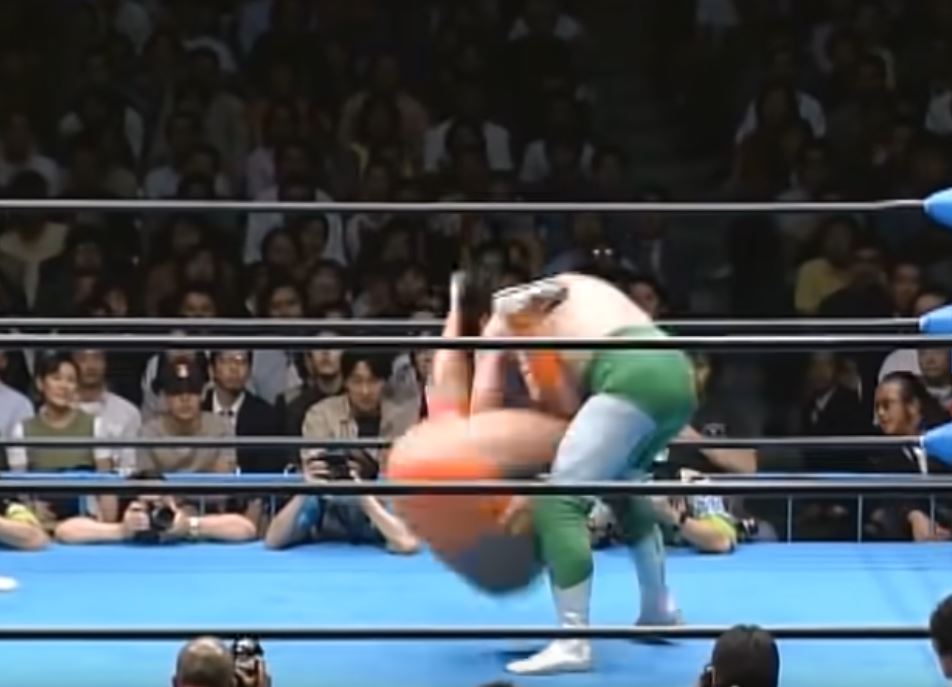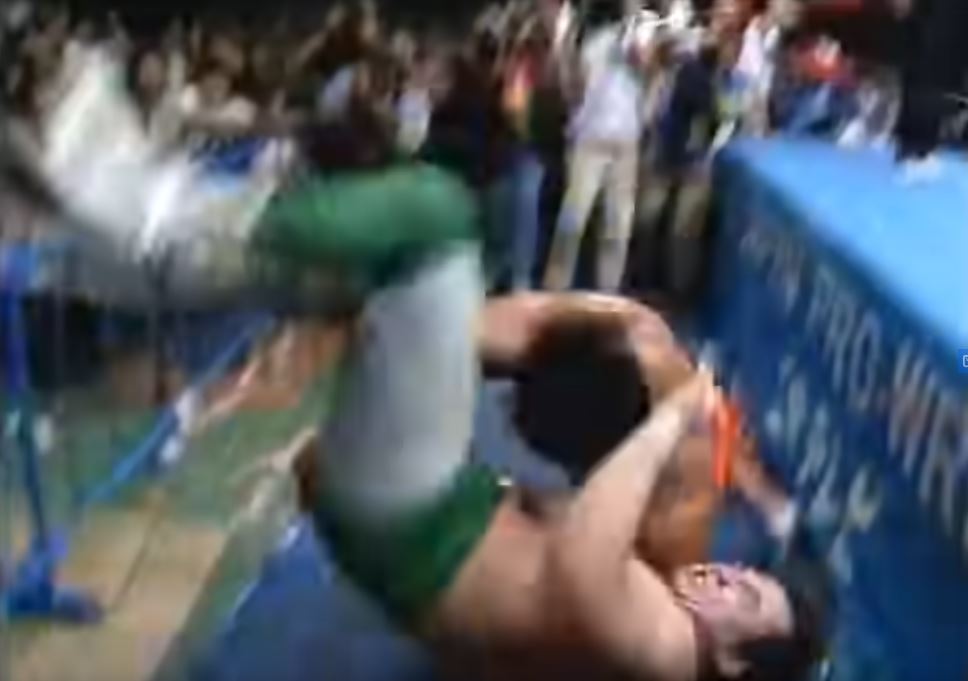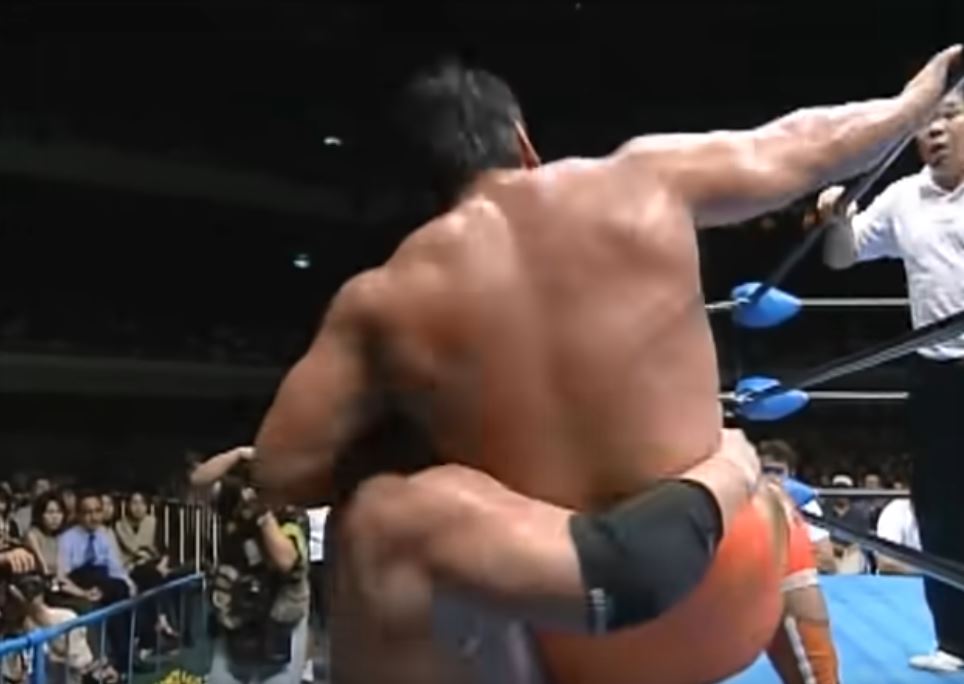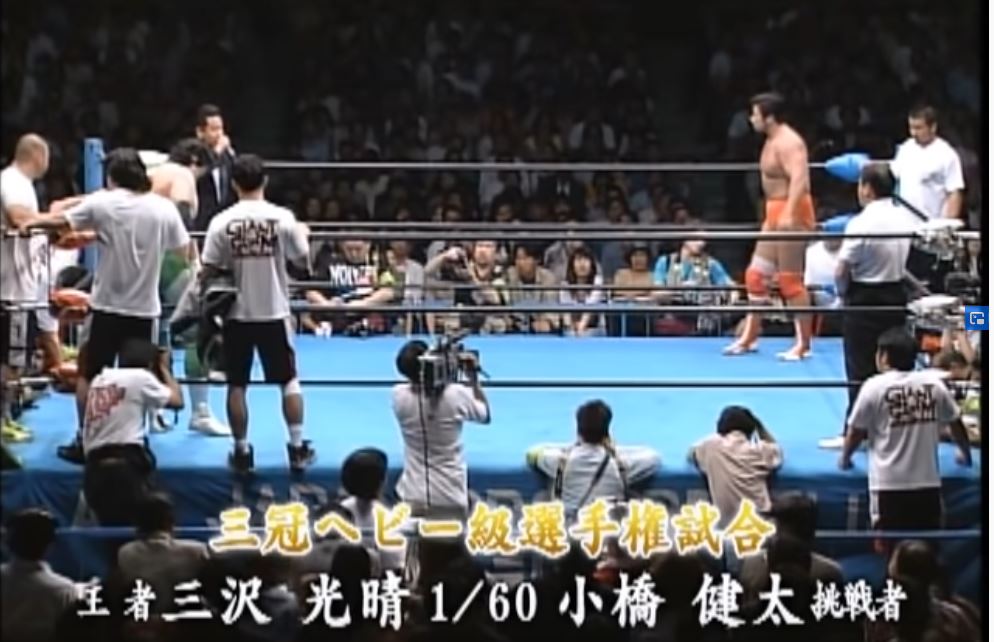This was one of the best wrestling matches of the entire year back in 1999. It was yet another example of why these two men are lauded so frequently as the best of all time.
Even after wrestling with each other many times, they still managed to tell a new story and maintain their high standards as wrestlers.
Today we look at one of the best matches in AJPW history: Misawa vs Kobashi from June 11, 1999.
Misawa vs Kobashi – 6-11-99
– Backstory
This was the third in a trilogy of epic singles title matches between Mitsuharu Misawa and Kenta Kobashi during the late 1990s.
The first one was on January 20th, 1997 and the second was on October 31st, 1998. In both of those matches, Kobashi lost the Triple Crown Heavyweight Championship to Misawa.
Each of those matches also furthered the professional rivalry between them. Kobashi, like Kawada before him, was unable to beat Misawa in high-profile singles competition.
Unlike Misawa’a rivalry with Kawada, the one with Kobashi was strictly professional. But like the Kawada rivalry, Misawa’s opponent grew desperate to finally topple the ace of AJPW.
This match, like other AJPW classics, features callbacks to things that happened in their earlier matches.
Some callbacks were from the two matches mentioned above, while others were from events that happened even earlier. This helped make this one of the most unpredictable matches of its day.
The key thing about those first two matches is they were so different from another. The 1997 bout had airtight psychology and targeting body parts to create believable and exciting near-fall sequences.
Meanwhile, the 1998 bout was a war of attrition that made viewers wonder how either man could survive so much punishment.
This match took the best things from both of those matches to create something even better.
Misawa vs Kobashi – 6-11-99
Act I
To show how much he has learned, the first thing Kobashi does when they lock up is to apply a cross armbreaker. He’s fully aware that Misawa’s elbows are lethal, so he targets them immediately. That small action sets the tone for the rest of the match.

Kobashi controlled most of the opening minutes by wearing down Misawa’s arms and neck. He had to work smart, especially since his strategy of throwing bombs at Misawa cost him the match in 1998.
But Misawa was Misawa and always had a way to escape Kobashi’s control.
But Kobashi fought back harder than ever. The two of them went toe-to-toe many times with their famous stiff strikes.
They knew each other so well that they managed to surprise each other with how they reacted to different moves. Misawa would hit a flurry of elbows, and Kobashi would tank them like a boss.
Kobashi would land a discus chop, and Misawa would tense up for a second one, but Kobashi would turn it into a kick instead, catching Misawa off guard.
Sometimes, they’d duck an attack; sometimes, they’d block; sometimes, they’d reverse; and other times, they’d just absorb the pain. They knew exactly how to keep each other – and therefore the audience – guessing what was going to happen next.
A perfect example of this was the segue into the next act. Misawa kicked Kobashi out of the ring and charged for the ropes.
From here, he could’ve done one of many things: skinned the cat and gone back into the ring, dove through the ropes, landed on the apron, climbed the turnbuckle, and so on.
Then, in the span of seconds, Misawa’s momentum came to a crashing halt as Kobashi caught him with a powerslam in mid-air.

Misawa vs Kobashi – 6-11-99
Act II
This next part of the match saw Kobashi replicate some things he did in the 1997 match. He attacked Misawa’s arm with even more brutality than before.
He smashed it into the guardrail, over his massive shoulder, over a steel chain, among others. Even as Misawa tried to fire back, he couldn’t hit more than one elbow strike because he was in that much pain.
And when Misawa blocked a Half-Nelson Suplex from Kobashi, Kobashi smartly rolled through into another cross-arm breaker to continue attacking that arm.
Because a wrestling match shouldn’t be about just hitting your big moves. A truly great wrestler knows how to change a match’s structure and sequencing to show logic and have things make sense while also being exciting and unpredictable.
Misawa knew his arm was in bad shape, so he tried to adapt by kicking Kobashi instead. But Kobashi soon taught on and began blocking them as well.
Then he hit a flurry of suplexes, but instead of going for a pin, he went right back to the arm because Misawa wouldn’t be able to block or resist his arm being wrenched into a submission hold.
Kobashi continued the onslaught until, once again, Misawa found a way to regain control. As Kobashi stood on the apron, Misawa came from underneath, elbowed him in the back of the knee (which had long been a weak spot of Kobashi’s), and suplexed him from the apron.

Misawa vs Kobashi –
Act III
Misawa began his comeback with a Tiger Driver, but like before, he couldn’t capitalize on it right away because of the damage to his arm.
So he tried to weaken Misawa with a massive bomb and attempted the Tiger Driver from the apron, which helped him win their match in 1998. But this time, Kobashi had that scouted, and Misawa couldn’t land that move as he had before.
From here, the match turned into a tribute to their 1998 encounter, with bombs being thrown one after another. Powerbombs, suplexes, slams, and hard strikes were thrown, but nothing was enough to keep either man down for more than two seconds.
Kobashi even teased the Burning Hammer, and when Misawa blocked that, Kobashi cleaved his head off with a lariat off the top rope, which is what Stan Hansen had done to Kobashi back in 1993.

Kobashi kept searching for a way to keep Misawa down, but nothing worked. And even as he started getting into a pattern of being in control, Misawa kept reversing whatever Kobashi did.
As Kobashi tried to powerbomb him, Misawa reversed it into a Frankensteiner that sent Kobashi flying into the steel ring barricade. And just like that, Misawa was back in control.
Callbacks
After weakening Kobashi’s lariat arm with elbow strikes, Misawa started his final comeback. First, he dropped Misawa with a running elbow smash, which is what won him their 1997 encounter.
But that wasn’t enough to score him the pinfall. Then he landed the Tiger Driver ’91, which had been Misawa’s super finisher for many years.
But Kobashi kicked out of that, just like in both 1997 and 1998. Then, he tried the rolling elbow, but Kobashi still wouldn’t stay down.
Then, as Kobashi mounted a desperation comeback, Misawa nailed him with the stiff one-two elbow combo that gave Misawa the win in 1998. But unlike in that match, Kobashi didn’t go down. He didn’t so much as fall; he somehow stayed on his feet.
Sensing there was nothing else left, Misawa had no other choice but to land his newest big match finisher. He hoisted Kobashi onto his shoulder and dropped him with the Emerald Flowsion, winning the match.
Misawa vs Kobashi –
Legacy
Whether in a vacuum or as part of a larger story, this match is one of the greatest of all time. It took the best parts of two earlier epics, added an even more exciting finishing sequence, and made something special.
This is how you make two wrestlers into absolute legends. Throughout the match, they showed incredible strength, toughness, adaptability, and intelligence.
This is truly a must-see match. It blows most modern matches out of the water, especially since it really only features one dive.

